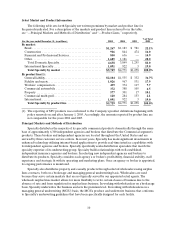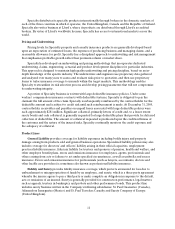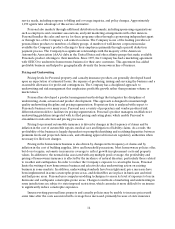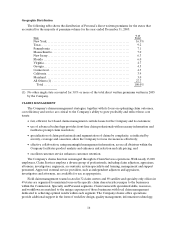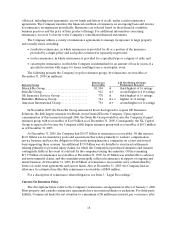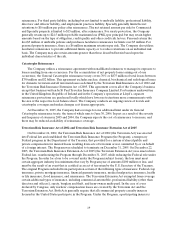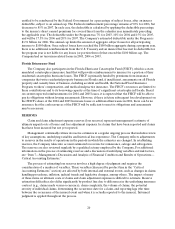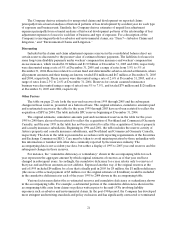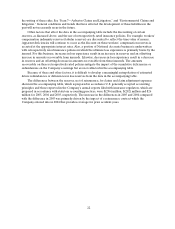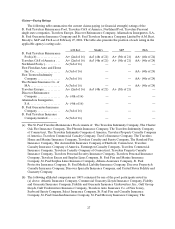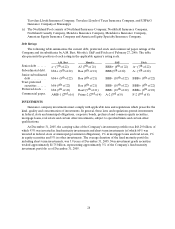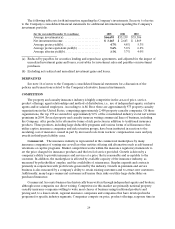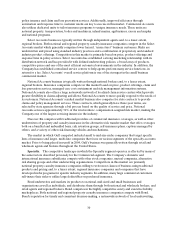Travelers 2005 Annual Report Download - page 32
Download and view the complete annual report
Please find page 32 of the 2005 Travelers annual report below. You can navigate through the pages in the report by either clicking on the pages listed below, or by using the keyword search tool below to find specific information within the annual report.20
entitled to be reimbursed by the Federal Government for a percentage of subject losses, after an insurer
deductible, subject to an annual cap. The Federal reimbursement percentage remains at 90% for 2006, but
decreases to 85% in 2007. In each case, the deductible is calculated by applying the deductible percentage
to the insurer’s direct earned premiums for covered lines from the calendar year immediately preceding
the applicable year. The deductible under the Program was 7% for 2003, 10% for 2004 and 15% for 2005,
and will be 17.5% for 2006 and 20% for 2007. The Company’s estimated deductible under the Program is
$1.91 billion for 2006. The annual cap limits the amountof aggregate subject losses for all participating
insurers to $100 billion. Once subject losses have reached the $100 billion aggregate during a program year,
there is no additional reimbursement from the U.S. Treasury and an insurer that has met its deductible for
the program year is not liable for any losses (or portion thereof) that exceed the $100 billion cap. The
Company had no terrorism-related losses in 2005, 2004 or 2003.
Florida Reinsurance Fund
The Company also participates in the Florida Hurricane Catastrophe Fund (FHCF), which is a state-
mandated catastrophe reinsurance fund that will provide reimbursement to insurers for a portion of their
residential catastrophic hurricane losses. The FHCFis primarily funded by premiums from insurance
companies that write residential property business in Florida and, if insufficient, assessments on all Florida
property and casualty lines of business, excluding accident and health, the National Flood Insurance
Program, workers’ compensation, and medical malpractice insurance. The FHCF’s resources are limited to
these contributions and to its borrowing capacity at the time of a significant catastrophe in Florida. Based
on current expected reimbursements for 2004 and 2005 losses, it is expected that the FHCFwill be able to
pay its obligations without levying assessments. However, if there is future subsequent loss development on
the FHCF’s share of the 2004 and 2005hurricane losses or additional hurricanes in2006, there can be no
assurance that the cash resources of the FHCF will be sufficient to meet its obligations and assessments
may be necessary.
RESERVES
Claim and claim adjustment expense reserves (loss reserves) represent management’s estimate of
ultimate unpaid costs of losses and loss adjustment expenses for claims that have been reported and claims
that have been incurred but not yet reported.
Management continually refines its reserve estimates in a regular ongoing process that includes review
of key assumptions, underlying variables and historical loss experience. The Company reflects adjustments
to reserves in the results of operationsin the periods in which the estimates are changed. In establishing
reserves, the Company takes into account estimated recoveries for reinsurance, salvage and subrogation.
The reserves are also reviewed regularly by a qualified actuary employed by the Company. For additional
information on the process of estimatingreserves and a discussion of underlying variables and riskfactors,
see “Item 7—Management’s Discussion and Analysis of Financial Condition and Results of Operations—
Critical Accounting Estimates.”
The process of estimating loss reserves involves a high degree of judgment and requires the
consideration of a number of variables. These variables (discussed by product line in the “Critical
Accounting Estimates” section) are affected by both internal and external events, such as changes in claims
handling procedures, inflation, judicial trends and legislative changes, among others. The impact of many
of these items on ultimate costs of claims and claim adjustment expenses is difficult to estimate. Reserve
estimation difficulties also differ significantly by product line due to differences in the underlyinginsurance
contract (e.g., claims made versus occurrence), claim complexity, the volume of claims, the potential
severity of individual claims, determining the occurrence date for a claim, and reporting lags (the time
between the occurrence of the insured event and when it is actually reported to the insurer). Informed
judgment is applied throughout the process.


